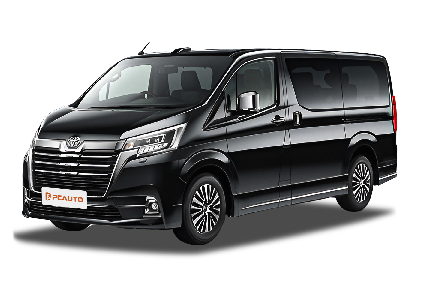Q
Is Granvia rear-wheel drive?
Yes, the Toyota Granvia in the Malaysian market uses a rear-wheel drive (RWD) layout. This type of drivetrain typically provides better load-carrying capacity and stability for the vehicle, especially suitable for situations with multiple passengers or heavy luggage. That's why many large MPVs and commercial vehicles tend to adopt rear-wheel drive design. The advantage of rear-wheel drive is that the power transmission is more direct, and it performs even better when climbing hills or when the vehicle is fully loaded. However, it should be noted that the handling of rear-wheel drive vehicles on slippery roads may be a bit more challenging than that of front-wheel drive vehicles, so more caution is needed when driving.
If you have more questions about the driving experience or maintenance of the Granvia, you can also refer to the owner's manual provided by Toyota Malaysia officially or consult the local authorized dealers. They can offer more detailed vehicle configurations and driving suggestions.
In addition, considering Malaysia's rainy climate, it is particularly important for rear-wheel drive vehicles to regularly check the tire condition and maintain proper tire pressure. This can ensure driving safety and optimize fuel efficiency.
Special Disclaimer: This content is published by users and does not represent the views or position of PCauto.
Related Q&A
Q
How many kilometers will a Hiace last?
As a commercial vehicle model known for its durability, the Toyota Hiace enjoys a good reputation in the Malaysian market. Its service life mainly depends on daily maintenance and driving habits. Under normal circumstances, a well-maintained Hiace can travel 300,000 to 500,000 kilometers or even more. Many commercial vehicle owners in Malaysia have reported that their Hiace vehicles still perform well after reaching 400,000 kilometers. The key is to regularly replace vulnerable parts such as engine oil, transmission oil, and timing belts, and pay attention to checking the chassis and engine conditions.
It's worth mentioning that the hot and humid climate in Malaysia has a significant impact on the rubber parts and electronic components of vehicles. It is recommended that owners shorten the maintenance cycle and pay special attention to the maintenance of the air-conditioning system and circuits. Meanwhile, the diesel engine of the Hiace is designed to focus on high torque at low speeds, which is very suitable for the mountainous roads and frequent stop-and-go traffic conditions in Malaysia. This design also helps to extend the engine life.
For consumers considering buying a used Hiace, it is recommended to focus on checking the engine condition, the smoothness of the transmission shift, and the rust situation of the vehicle body. These factors can reflect the real condition of the vehicle better than simply looking at the mileage.
Q
What is the difference between Toyota Hiace and Granvia?
Although the Toyota Hiace and Granvia are both commercial vehicle models under Toyota, they have obvious differences in positioning, design, and functionality. The Hiace focuses on practicality and economy, offering various body sizes and seating configurations (such as van or passenger versions). It is suitable for logistics transportation or large-family trips. In terms of power, it usually comes with a 2.8L diesel engine, emphasizing fuel efficiency and durability.
On the other hand, the Granvia is positioned more upscale. It is built on the Hiace platform but places greater emphasis on comfort. The interior materials are more refined, with high-end seats and an entertainment system as standard equipment. It is suitable for business receptions or luxury group outings. The power options may include a 3.0L diesel engine or hybrid alternatives.
Expanding on this, Malaysian users can consider their usage and budget when making a choice. The Hiace is ideal for commercial scenarios where cost-performance is a priority, while the Granvia is suitable for customers who pursue a comfortable experience. Both models are well-known for Toyota's reliability, and there is a comprehensive local after-sales network, which makes maintenance and servicing convenient.
Q
Are Toyota Granvia reliable?
In the Malaysian market, the Toyota Granvia is well-favored by many family and business users for its reliability and practicality. This MPV, built on the Toyota HIACE platform, inherits the Toyota brand's consistent durability. The 2.8-liter diesel engine (as in the Granvia Premium configuration) has been long-term tested in the market. It offers a smooth power output and good fuel economy, which is suitable for long-distance driving or passenger-carrying needs. Its maintenance cost is relatively reasonable, and with Toyota's extensive service network, parts supply is also quite convenient, reducing concerns about post-purchase maintenance.
However, like all diesel vehicles, regular maintenance of the turbocharging system and fuel injection device is crucial. It is recommended to follow the manufacturer's specified maintenance schedule to extend its service life. Compared with MPVs in the same class, such as the Honda Stepwagon or Nissan Serena, the Granvia has an edge in terms of more spacious seating and Toyota's brand reputation. But in terms of fuel consumption and handling flexibility, it may be slightly inferior to some gasoline-powered competitors.
If you value space and reliability and often have the need to carry multiple passengers, the Granvia is worth considering. But it is advisable to take a test drive and compare it with other models in the same class. Also, pay attention to the condition of used cars in the second-hand market, as maintenance records are especially important for diesel vehicles.
Latest Q&A
Q
What is the top model of Toyota Yaris 2019?
The top trim of the 2019 Toyota Yaris is the 1.5G variant. It's powered by a 1.5-liter Dual VVT-i naturally aspirated engine that cranks out 107 horsepower, paired with a 7-speed CVT transmission for a smooth driving experience and solid fuel efficiency. This trim comes standard with LED headlights, a smart key system, automatic climate control, and a 7-inch touchscreen infotainment system that supports Apple CarPlay and Android Auto, boosting both tech appeal and convenience. On the safety front, the 1.5G is equipped with vehicle stability control, six airbags, and a reverse camera to keep you secure on the road. As the flagship of the Yaris lineup, the 1.5G steps up its game in comfort and functionality, making it a solid pick for shoppers after a high-quality subcompact. It's worth noting that the Yaris has long been known globally for its reliability and low maintenance costs, and the 2019 model gets tweaks to handling and sound insulation, further cementing its competitiveness in the segment.
Q
What are the trim levels for the 2019 Toyota Yaris?
The 2019 Toyota Yaris was available locally in three main trim levels: 1.5E, 1.5G, and 1.5V. All came equipped with a 1.5-liter Dual VVT-i naturally aspirated engine paired with a 7-speed CVT transmission. The base 1.5E came standard with LED daytime running lights, manual air conditioning, and a 2-DIN audio system. Stepping up to the 1.5G added smart keyless entry, push-button start, and 15-inch alloy wheels. The top-of-the-line 1.5V rounded things off with automatic climate control, a leather-wrapped steering wheel, and paddle shifters. It's worth noting that this Yaris featured Toyota's latest GOA body technology, and across the entire lineup, you got seven airbags, VSC vehicle stability control, and HAC hill-start assist as standard safety kit. If you're considering a used one, make sure to check the CVT transmission fluid change records and the condition of the undercarriage—this powertrain is pretty sensitive to regular maintenance. While competitors like the Honda Jazz offer more flexible interior space, the Yaris leans more towards comfort with its noise insulation and chassis tuning, making it a solid pick for daily city driving.
Q
What is the mileage of Toyota Yaris 2019?
The fuel efficiency of the 2019 Toyota Yaris varies depending on the trim and powertrain. The version with the 1.5-liter naturally aspirated engine averages around 6.5 L/100km in city driving, dropping to roughly 5.0 L/100km on the highway. The hybrid model is even thriftier, with a combined fuel consumption of about 4.0 L/100km. Actual numbers might fluctuate slightly based on driving habits and road conditions.
This car has gained popularity for being economical and practical, making it a solid pick for daily commutes and family use. Maintenance costs are relatively low, parts are readily available, and repairs are hassle-free. For shoppers who prioritize fuel economy, the Yaris is a great option—plus, its reliability and durability have been proven in the market, saving you money over the long haul. To squeeze out even better mileage, keeping your tires properly inflated and avoiding hard acceleration or sudden braking can go a long way in boosting fuel efficiency.
Q
How big is the gas tank on a 2019 Toyota Yaris?
The 2019 Toyota Yaris comes with a 42-liter fuel tank, a design that meets daily commuting and short to medium-distance travel needs, balancing fuel efficiency with practicality. Powered by a 1.5-liter naturally aspirated engine paired with a CVT transmission, this model delivers a combined fuel consumption of approximately 5.2 liters per 100 kilometers, meaning a full tank theoretically offers a range of around 800 kilometers. It's worth noting that the actual usable tank capacity might be slightly less than the rated value; this is a standard industry practice to leave safe space for fuel expansion. We recommend drivers refuel when the fuel level drops to 1/4 to prevent premature wear on the fuel pump from prolonged operation at low levels. For more precise tank specifications, check the vehicle owner's manual or use the fuel gauge reset method for actual testing. Additionally, regular maintenance of the fuel system can effectively maintain tank cleanliness and fuel supply efficiency.
Q
What oil does a 2019 Toyota Yaris take?
The 2019 Toyota Yaris recommends using fully synthetic 0W-20 motor oil that meets API SN or higher standards. This low-viscosity oil optimizes cold-start protection and improves fuel efficiency. If this specific viscosity isn't readily available, 5W-30 can be used as a substitute, though you might notice a slight increase in fuel consumption. For maintenance, it's advised to change the oil every 10,000 kilometers or 6 months, whichever comes first. In hot climates or with frequent short trips, you may want to shorten the oil change interval a bit. A key point to note: some models with the 1.5L 2NR-FE engine equipped with a start-stop system must use "Resource Conserving" labeled fuel-efficient oil to ensure proper system operation. When choosing oil, prioritize products that meet the Toyota-certified ILSAC GF-5 standard. These oils have a more balanced additive package, effectively preventing low-speed pre-ignition and protecting the emission control system. If your vehicle is still under warranty, it's best to use the original factory oil to avoid warranty disputes. Also, regularly check the oil dipstick to ensure the level is within the normal range—excessive oil consumption could be an early sign of aging piston rings or valve seals.
View MoreRelated News

Which one is better, Honda City or Toyota Vios?
AshleyNov 11, 2025

2026 Toyota Hilux Travo released, the brand-new exterior and interior are highly anticipated
LienNov 11, 2025

Should I choose the top-tier Toyota Corolla Cross, or the entry-level Fortuner?
Kevin WongNov 6, 2025

Why are people more willing to choose Toyota Hilux instead of Isuzu D-Max?
JamesNov 3, 2025

In Malaysia, which sliding door MPVs are available?
MichaelOct 30, 2025
View More











Pros
Cons